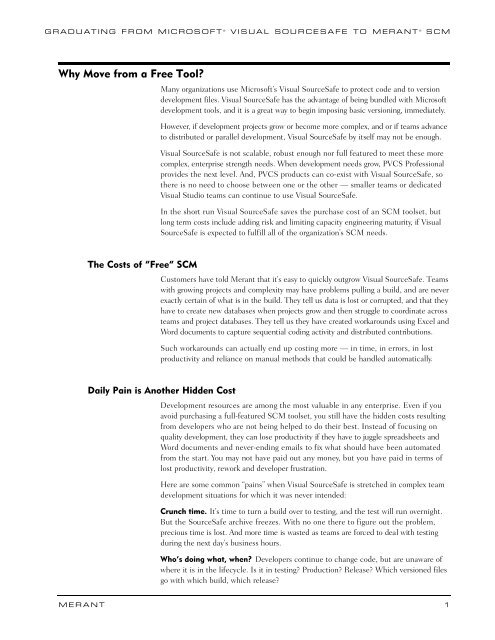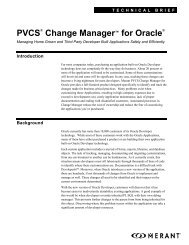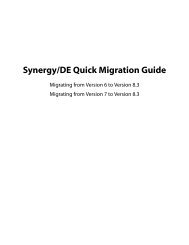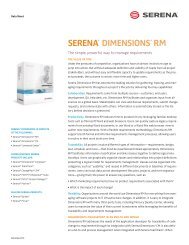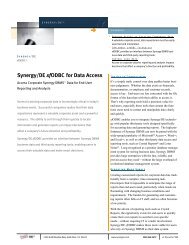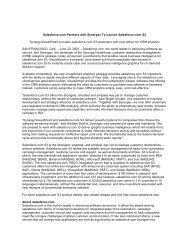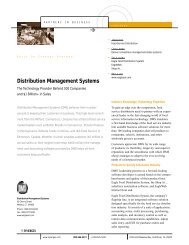Graduating from microsoft visual sourcesafe to ... - PVCS - Synergex
Graduating from microsoft visual sourcesafe to ... - PVCS - Synergex
Graduating from microsoft visual sourcesafe to ... - PVCS - Synergex
Create successful ePaper yourself
Turn your PDF publications into a flip-book with our unique Google optimized e-Paper software.
G R A D U ATING FROM MICROSOFT ® VISUAL SOURCESAFE TO MERANT ® S C M<br />
Why Move <strong>from</strong> a Free Tool?<br />
Many organizations use Microsoft’s Visual SourceSafe <strong>to</strong> protect code and <strong>to</strong> version<br />
development files. Visual SourceSafe has the advantage of being bundled with Microsoft<br />
development <strong>to</strong>ols, and it is a great way <strong>to</strong> begin imposing basic versioning, immediately.<br />
H o w e v e r, if development projects grow or become more complex, and or if teams advance<br />
<strong>to</strong> distributed or parallel development, Visual SourceSafe by itself may not be enough.<br />
Visual SourceSafe is not scalable, robust enough nor full featured <strong>to</strong> meet these more<br />
complex, enterprise strength needs. When development needs grow, <strong>PVCS</strong> Professional<br />
provides the next level. And, <strong>PVCS</strong> products can co-exist with Visual SourceSafe, so<br />
there is no need <strong>to</strong> choose between one or the other — smaller teams or dedicated<br />
Visual Studio teams can continue <strong>to</strong> use Visual SourceSafe.<br />
In the short run Visual SourceSafe saves the purchase cost of an SCM <strong>to</strong>olset, but<br />
long term costs include adding risk and limiting capacity engineering maturity, if Vi s u a l<br />
SourceSafe is expected <strong>to</strong> fulfill all of the organization’s SCM needs.<br />
The Costs of “Free” SCM<br />
Cus<strong>to</strong>mers have <strong>to</strong>ld Merant that it’s easy <strong>to</strong> quickly outgrow Visual SourceSafe. Teams<br />
with growing projects and complexity may have problems pulling a build, and are never<br />
exactly certain of what is in the build. They tell us data is lost or corrupted, and that they<br />
have <strong>to</strong> create new databases when projects grow and then struggle <strong>to</strong> coordinate across<br />
teams and project databases. They tell us they have created workarounds using Excel and<br />
Word documents <strong>to</strong> capture sequential coding activity and distributed contributions.<br />
Such workarounds can actually end up costing more — in time, in errors, in lost<br />
productivity and reliance on manual methods that could be handled au<strong>to</strong>matically.<br />
Daily Pain is Another Hidden Cost<br />
Development resources are among the most valuable in any enterprise. Even if you<br />
avoid purchasing a full-featured SCM <strong>to</strong>olset, you still have the hidden costs resulting<br />
<strong>from</strong> developers who are not being helped <strong>to</strong> do their best. Instead of focusing on<br />
quality development, they can lose productivity if they have <strong>to</strong> juggle spreadsheets and<br />
Word documents and never-ending emails <strong>to</strong> fix what should have been au<strong>to</strong>mated<br />
<strong>from</strong> the start. You may not have paid out any money, but you have paid in terms of<br />
lost productivity, rework and developer frustration.<br />
Here are some common “pains” when Visual SourceSafe is stretched in complex team<br />
development situations for which it was never intended:<br />
Crunch time. It’s time <strong>to</strong> turn a build over <strong>to</strong> testing, and the test will run overnight.<br />
But the SourceSafe archive freezes. With no one there <strong>to</strong> figure out the problem,<br />
precious time is lost. And more time is wasted as teams are forced <strong>to</strong> deal with testing<br />
during the next day’s business hours.<br />
Who’s doing what, when? Developers continue <strong>to</strong> change code, but are unaware of<br />
where it is in the lifecycle. Is it in testing? Production? Release? Which versioned files<br />
go with which build, which release?<br />
M E R A N T<br />
1


